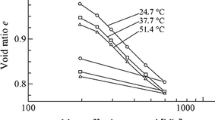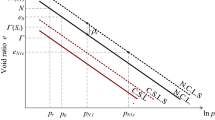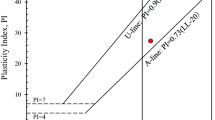Abstract
In this paper, by introducing a new yielding mechanism based on the widely acknowledged double-structure theory, the original UH model for unsaturated soils is extended to capture the behaviour of expansive clays. A novel expansion potential is further established to evaluate the effect of overconsolidation on the volume change of unsaturated expansive clays during wetting. With only one additional parameter, the proposed model can describe the behaviour of both wetting-collapse and wetting-induced swelling for unsaturated clays. Comparisons between model predictions and test results show a good agreement which verifies the capability of the proposed model in charactering the features of unsaturated expansive clays under various stress histories and stress paths.












Similar content being viewed by others
Abbreviations
- \({D}_{ijkl}^{\mathrm{ep}}\) :
-
Elasto-plastic constitutive tensor
- \(E\) :
-
Elastic modulus
- \(f\) :
-
Current yield function
- \(\overline{f }\) :
-
Reference yield surface
- \(\widetilde{f}\) :
-
Current yield surface in the transformed stress space
- \({f}_{\mathrm{d}}\) :
-
Magnification factor
- \(G\) :
-
Shear modulus
- \(H\) :
-
Unified hardening parameter
- \(J\) :
-
Material parameter representing the swelling capacity of expansive clays
- \(K\) :
-
Elastic bulk modulus
- \(k\) :
-
A constant describing the increase in cohesion with suction
- \({K}_{\mathrm{m}}\) :
-
Scale factor for determinate macrostructural plastic volumetric strain
- \(L\) :
-
Lame’s constant
- \(M\) :
-
Characteristic state stress ratio
- \({M}_{\mathrm{Ys}}\) :
-
Potential failure stress ratio
- \({\widetilde{M}}_{\mathrm{Ys}}\) :
-
Potential failure stress ratio in transformed stress space
- \(p\) :
-
Net mean stress
- \(\widehat{p}\) :
-
Mean stress considering the suction
- \(\overline{p }\) :
-
Reference mean effective stress
- \(\widetilde{p}\) :
-
Mean net stress in transformed stress space
- \(\widetilde{\overline{p} }\) :
-
Reference mean effective stress in transformed stress space
- \({p}_{\text{at}}\) :
-
Atmospheric pressure
- \({p}^{\mathrm{c}}\) :
-
Reference suction stress
- \({p}_{s}\) :
-
Suction stress
- \({p}_{\mathrm{x}}\) :
-
Right intersection of current yield surface and p-axis
- \({\overline{p} }_{\mathrm{x}}\) :
-
Right intersection of reference yield surface and p-axis
- \({p}_{\mathrm{x}}^{*}\) :
-
Preconsolidation pressures for saturated clays
- \({\overline{p} }_{\mathrm{x}}^{*}\) :
-
Right intersection of the reference yield surface and the p axis for saturated clays
- \({\overline{p} }_{\mathrm{x}0}\)::
-
Right intersection of reference yield surface and p-axis in the initial condition
- \(q\) :
-
Deviatoric stress
- \(\widehat{q}\) :
-
Deviatoric stress considering the suction
- \(\overline{q }\) :
-
Reference deviatoric stress
- \(\widetilde{q}\) :
-
Deviatoric stress in transformed stress space
- \({\widehat{q}}_{\mathrm{c}}\) :
-
Deviatoric stress under triaxial compression condition in the SMP criterion
- \({R}_{\mathrm{s}}\) :
-
Overconsolidation parameter
- \({\widetilde{R}}_{\mathrm{s}}\) :
-
Overconsolidation parameter in transformed stress space
- \({s}_{0}\) :
-
Maximum suction in history
- \({X}_{\mathrm{m}}\) :
-
Scale factor for determinate microstructural volumetric strain
- \(\beta\) :
-
Material parameter controlling the rate of increase of soil stiffness with suction
- \(\gamma\) :
-
Material parameter defining the maximum soil stiffness
- \({\delta }_{ij}\) :
-
Kronecker’s delta
- \({\varepsilon }_{\mathrm{d}}\) :
-
Total deviatoric strain
- \({\varepsilon }_{\mathrm{d}}^{\mathrm{e}}\) :
-
Elastic deviatoric strain
- \({\varepsilon }_{\mathrm{d}}^{\mathrm{p}}\) :
-
Plastic deviatoric strain
- \({\varepsilon }_{kl{\mathrm{p}}_{\mathrm{m}}}^{\mathrm{p}}\) :
-
Plastic strain induced by the microstructural deformation
- \({\varepsilon }_{kl{\mathrm{p}}_{\mathrm{s}}}^{\mathrm{e}}\) :
-
Elastic strain induced by \({p}_{\mathrm{s}}\)
- \({\varepsilon }_{\mathrm{m}}\) :
-
Microstructural volumetric strain
- \({\varepsilon }_{\mathrm{v}}\) :
-
Total volumetric strain
- \({\varepsilon }_{\mathrm{v}}^{\mathrm{e}}\) :
-
Elastic volumetric strain
- \({\varepsilon }_{\mathrm{vp}}^{\mathrm{e}}\) :
-
Elastic volumetric strain induced by the change of the net stress
- \({\varepsilon }_{\mathrm{vp}}^{\mathrm{p}}\) :
-
Plastic volumetric strain induced by the expansion of the current LC yield surface
- \({\varepsilon }_{\mathrm{vs}}\) :
-
Volumetric strain induced by the suction change
- \({\varepsilon }_{\mathrm{vs}}^{\mathrm{e}}\) :
-
Elastic volumetric strain induced by the suction change
- \({\varepsilon }_{\mathrm{vs}}^{\mathrm{p}}\) :
-
Macrostructural plastic volumetric strain induced by suction change
- \(\widehat{\eta }\) :
-
Stress ratio
- \(\widetilde{\eta }\) :
-
Stress ratio in transformed stress space
- \(\widehat{\theta }\) :
-
Lode’s angel
- \(\kappa\) :
-
Slope of unloading line for unsaturated clays
- \({\kappa }_{\mathrm{s}}\) :
-
Slope of compression line in the \(e-\mathrm{ln}s\) plane when the suction is less than or equal to \({s}_{0}\)
- \(\Lambda\) :
-
Plastic multiplier
- \(\lambda \left(0\right)\) :
-
Slope of the compression curves for saturated clays
- \(\lambda \left(s\right)\) :
-
Slope of the compression curves for unsaturated clays with the suction s
- \({\lambda }_{\mathrm{s}}\) :
-
Slope of compression line in the \(e-\mathrm{ln}s\) plane when the suction exceeds \({s}_{0}\)
- \(v\) :
-
Poisson’s ratio
- \({\rho }_{\mathrm{d}}\) :
-
Initial dry density
- \({\rho }_{\mathrm{w}}\) :
-
Density of water
- \({\sigma }_{i}\) :
-
Principal stress
- \({\widehat{\sigma }}_{i}\) :
-
Principal stress considering the suction
- \({\sigma }_{ij}\) :
-
Stress tensor
- \({\widehat{\sigma }}_{ij}\) :
-
Stress tensor considering the suction
- \({\widetilde{\sigma }}_{ij}\) :
-
Transformed stress tensor
- \({\sigma }_{ij}^{{\mathrm{p}}_{\mathrm{s}}}\) :
-
Stress related to \({p}_{\mathrm{s}}\)
- \({\sigma }_{\mathrm{v}}\) :
-
Vertical pressures
- \(\widehat{\Omega }\) :
-
Coefficient related to overconsolidation
- \(\widetilde{\Omega }\) :
-
Coefficient related to overconsolidation in transformed stress space
References
Alonso EE, Gens A, Josa A (1990) A constitutive model for partially saturated soils. Géotechnique 40(3):405–430. https://doi.org/10.1680/geot.1990.40.3.405
Alonso EE, Lloret A, Gens A, Yang DQ (1995) Experimental behaviour of highly expansive double-structure clay. In: Proc 1st international conference on unsaturated soils 1: 11–6
Alonso EE, Vaunat J, Gens A (1999) Modelling the mechanical behaviour of expansive clays. Eng Geol 54(1–2):173–183. https://doi.org/10.1016/S0013-7952(99)00079-4
Chen R (2007) Experimental study and constitutive modelling of stress-dependent coupled hydraulic hysteresis and mechanical behaviour of an unsaturated soil. PhD thesis, The Hong Kong University of Science and Technology, China
Chiu CF, Ng CWW (2003) A state-dependent elastoplastic model for saturated and unsaturated soils. Géotechnique 53(9):809–829. https://doi.org/10.1680/geot.2003.53.9.809
Chu TY, Mou CH (1973) Volume change characteristics of expansive soils determined by controlled suction test. In: Proc 3rd international conference on expansive soils 1: 177–185
Escario V, Saez J (1986) The shear strength of partly saturated soils. Geotechnique 36(3):453–456. https://doi.org/10.1680/geot.1986.36.3.453
Gao Y, Li Z, Cui W, Sun DA, Yu HH (2023) Effect of initial void ratio on the tensile strength of unsaturated silty soils. Acta Geotech 18:3609–3622. https://doi.org/10.1007/s11440-023-01800-z
Gens A, Alonso EE (1992) A framework for the behaviour of unsaturated expansive clays. Can Geotech 29(6):1013–1032. https://doi.org/10.1139/t92-120
Kassiff G, Baker R, Ovadia Y (1973) Swell-pressure relationships at constant suction changes. In: Proc 3rd international conference on expansive soils 1: 201–208
Kayabali K, Demir S (2011) Measurement of swelling pressure: direct method versus indirect methods. Can Geotech 48(3):354–364
Kyokawa H (2021) A double structure model for hydro-mechano-chemical behavior of expansive soils based on the surface phenomena of mineral crystals. Eng Geol 294:106366. https://doi.org/10.1016/j.enggeo.2021.106366
Li J, Yin ZY, Cui YJ, Hicher PY (2017) Work input analysis for soils with double porosity and application to the hydro-mechanical modeling of unsaturated expansive clays. Can Geotech 54(2):173–187. https://doi.org/10.1139/cgj-2015-0574
Li W, Yang Q (2017) A macro-structural constitutive model for partially saturated expansive soils. Bull Eng Geol Environ 76(3):1075–1084. https://doi.org/10.1007/s10064-016-0933-z
Lloret A, Villar MV (2007) Advances on the knowledge of the thermo-hydro-mechanical behaviour of heavily compacted “FEBEX” bentonite. Phys Chem Earth, Parts A/B/C 32(8–14):701–715. https://doi.org/10.1016/j.pce.2006.03.002
Lloret-Cabot M, Wheeler SJ, Sánchez M (2017) A unified mechanical and retention model for saturated and unsaturated soil behavior. Acta Geotech 12:1–21. https://doi.org/10.1007/s11440-016-0497-x
Lu PH, Ye WM, He Y (2023) A constitutive model of compacted bentonite under coupled chemo-hydro-mechanical conditions based on the framework of the BExM. Comput Geotech 158:105360. https://doi.org/10.1016/j.compgeo.2023.105360
Lu ZH, Chen ZH, Sun SG (2002) Study on deformation and strength characteristic of expansive soil with triaxial tests. CJRME 21(5):717–723. https://doi.org/10.3321/j.issn:1000-6915.2002.05.024
Mašín D (2013) Double structure hydromechanical coupling formalism and a model for unsaturated expansive clays. Eng Geol 165:73–88. https://doi.org/10.1016/j.enggeo.2013.05.026
Matsuoka H, Nakai T (1974) Stress-deformation and strength characteristics of soil under three different principal stresses. Proceed Japan Soc Civil Eng 232:59–70. https://doi.org/10.2208/jscej1969.1974.232_59
Ng CWW, Zhou C, Chiu CF (2020) Constitutive modelling of state-dependent behaviour of unsaturated soils: an overview. Acta Geotech 15:2705–2725. https://doi.org/10.1007/s11440-020-01014-7
Pousada PE (1982) Deformabilidad de arcillas expansivas bajo succíon controlada. Doctoral thesis, Universidad Politénica deMadrid, Spain.
Sánchez M, Gens A, do Nascimento Guimarães L, Olivella S, (2005) A double structure generalized plasticity model for expansive materials. Int J Numer Anal Methods Geomech 29(8):751–787. https://doi.org/10.1002/nag.434
Sheng DC (2011) Review of fundamental principles in modelling unsaturated soil behaviour. Comput Geotech 38(6):757–776. https://doi.org/10.1016/j.compgeo.2011.05.002
Sun DA, Matsuoka H, Yao YP, Ichihara W (2000) An elastoplastic model for unsaturated soil in three-dimensional stresses. Soils Found 40(3):17–28. https://doi.org/10.3208/sandf.40.3_17
Sun DA, Sheng DC (2005) An elastoplastic hydro-mechanical model for unsaturated compacted soils. In: Tarantino A, Romero E, Cui YJ editors. Advanced experimental unsaturated soil mechanics 249–55.
Sun WJ, Sun DA (2012) Coupled modelling of hydro-mechanical behaviour of unsaturated compacted expansive soils. Int J Numer Anal Methods Geomech 36(8):1002–1022. https://doi.org/10.1002/nag.1036
Wang Q, Cui YJ, Tang AM, Li XL, Ye WM (2014) Time- and density-dependent microstructure features of compacted bentonite. Soils Found 54(4):657–666. https://doi.org/10.1016/j.sandf.2014.06.021
Wang Q, Tang AM, Cui YJ, Barnichon JD, Ye WM (2013) Investigation of the hydro-mechanical behaviour of compacted bentonite/sand mixture based on the BExM model. Comput Geotech 54:46–52. https://doi.org/10.1016/j.compgeo.2013.05.011
Wang Y (2020) A thermo-hydro-mechanical coupled constitutive model for bentonite based on critical saturation state surface. PhD thesis, Tongji University, China
Wang Y, Ye WM, Wang Q, Chen YG, Cui YJ (2022) A critical saturated state-based constitutive model for volumetric behavior of compacted bentonite. Can Geotech 59(11):1872–1886. https://doi.org/10.1139/cgj-2021-0213
Wheeler SJ, Sivakumar V (1995) An elasto-plastic critical state framework for unsaturated soil. Géotechnique 45(1):35–53. https://doi.org/10.1680/geot.1995.45.1.35
Yao YP, Matsuoka H, Sun DA (1999) A unified elastoplastic model for clay and sand with the SMP criterion. In: Proc 8th Australia-New Zealand conference on geomechanics 2: 997–1003
Yao YP, Sun DA (2000) Application of Lade’s criterion to Cam-clay model. J Eng Mech 126(1):112–119. https://doi.org/10.1061/(ASCE)0733-9399(2000)126:1(112)
Yao YP, Sun DA (2001) Closure of “application of Lade’s criterion to Cam-clay model.” J Eng Mech 127(6):632–633. https://doi.org/10.1061/(ASCE)0733-9399(2001)127:6(632)
Yao YP, Hou W, Zhou AN (2009) UH model: three-dimensional unified hardening model for overconsolidated clays. Géotechnique 59(5):451–469
Yao YP, Yang YF, Niu L (2011) UH model considering temperature effects. Sci China Technol Sci 54(1):190–202. https://doi.org/10.1007/s11431-010-4209-8
Yao YP, Kong YX (2012) Extended UH model: three-dimensional unified hardening model for anisotropic clays. J Eng Mech 138(7):853–866. https://doi.org/10.1061/(ASCE)EM.1943-7889.0000397
Yao YP, Gao ZW, Zhao JD, Wan Z (2012) Modified UH model: constitutive modeling of overconsolidated clays based on a parabolic Hvorslev envelope. J Geotech Geoenviron Eng 138(7):860–868. https://doi.org/10.1061/(ASCE)GT.1943-5606.0000649
Yao YP, Zhou AN (2013) Non-isothermal unified hardening model: a thermos-elasto-plastic model for clays. Geotechnique 63(15):1328–1345
Yao YP, Niu L, Cui WJ (2014) Unified hardening (UH) model for overconsolidated unsaturated soils. Can Geotech 51(7):810–821. https://doi.org/10.1139/cgj-2013-0183
Yao YP, Wang ND (2014) Transformed stress method for generalizing soil constitutive models. J Eng Mech 140(3):614–629
Yao YP, Kong LM, Zhou AN, Yin JH (2015) Time-dependent unified hardening model: three-dimensional elastoviscoplastic constitutive model for clays. J Eng Mech 141(6):04014162-1–04014162-18
Yao YP, Tian Y, Gao ZW (2017) Anisotropic UH model for soils based on a simple transformed stress method. Int J Numer Anal Methods Geomech 41:54–78. https://doi.org/10.1002/nag.2545
Ye WM, Huang Y, Cui YJ, Tang YQ, Delage P (2005) Microstructural changing characteristics of densely compacted bentonite with suction under unconfined hydrating conditions. CJRME 24(24):4570–4575
Ye WM, Schanz T, Qian LX, Wang J, Arifin Y (2007) Characteristics of swelling pressure of densely compacted Gaomiaozi bentonite GMZ01. CJRME 26(Suppl. 2):3861–3865
Zhan LT (2003) Field and laboratory study of an unsaturated expansive soil associated with rain-induced slope instability. PhD thesis, The Hong Kong University of Science and Technology, China
Zhan LT, Chen R, Ng CWW (2014) Wetting-induced softening behavior of an unsaturated expansive clay. Landslides 11(6):1051–1061
Zhou AN, Sheng DC (2015) An advanced hydro-mechanical constitutive model for unsaturated soils with different initial densities. Comput Geotech 63:46–66. https://doi.org/10.1016/j.compgeo.2014.07.017
Acknowledgements
This paper was supported by the National Natural Science Foundation of China (Grant Nos. 52238007, and 51979001) and the National Key Research and Development Plan of China (Grant No. 2018YFE0207100).
Author information
Authors and Affiliations
Corresponding author
Ethics declarations
Conflict of interest
The authors declare that they have no known competing financial interests or personal relationships that could have appeared to influence the work reported in this paper.
Additional information
Publisher's Note
Springer Nature remains neutral with regard to jurisdictional claims in published maps and institutional affiliations.
Appendix: Derivation of three-dimensional elastoplastic stress–strain relationship
Appendix: Derivation of three-dimensional elastoplastic stress–strain relationship
As shown in Fig. 4, \({\widehat{\sigma }}_{i}={\sigma }_{i}+{p}_{\mathrm{s}}\) is the principal stress considering the suction and \(\widehat{\theta }\) is the corresponding Lode’s angel. The transformation from the general stress space to the transformed stress space can be expressed as
where
Integrating Eq. (45), the UH model for unsaturated expansive clays in 3D stress space can be expressed using tensor as
where \({\sigma }_{ij}^{{\mathrm{p}}_{\mathrm{s}}}\) is the stress related to \({p}_{\mathrm{s}}\), \({\varepsilon }_{kl{\mathrm{p}}_{\mathrm{s}}}^{\mathrm{e}}\) is the elastic strain induced by \({p}_{\mathrm{s}}\), \({\varepsilon }_{kl{\mathrm{p}}_{\mathrm{m}}}^{\mathrm{p}}\) is the plastic strain induced by the microstructural swelling and \({D}_{ijkl}^{\mathrm{ep}}\) is the elasto-plastic constitutive tensor which can be expressed as:
where
\(\widetilde{f}\) is the current yield surface in the transformed stress space which can be expressed as
where
and
where
Rights and permissions
Springer Nature or its licensor (e.g. a society or other partner) holds exclusive rights to this article under a publishing agreement with the author(s) or other rightsholder(s); author self-archiving of the accepted manuscript version of this article is solely governed by the terms of such publishing agreement and applicable law.
About this article
Cite this article
Yao, Y., Tian, Y., Cui, W. et al. Unified hardening (UH) model for unsaturated expansive clays. Acta Geotech. (2023). https://doi.org/10.1007/s11440-023-02140-8
Received:
Accepted:
Published:
DOI: https://doi.org/10.1007/s11440-023-02140-8




